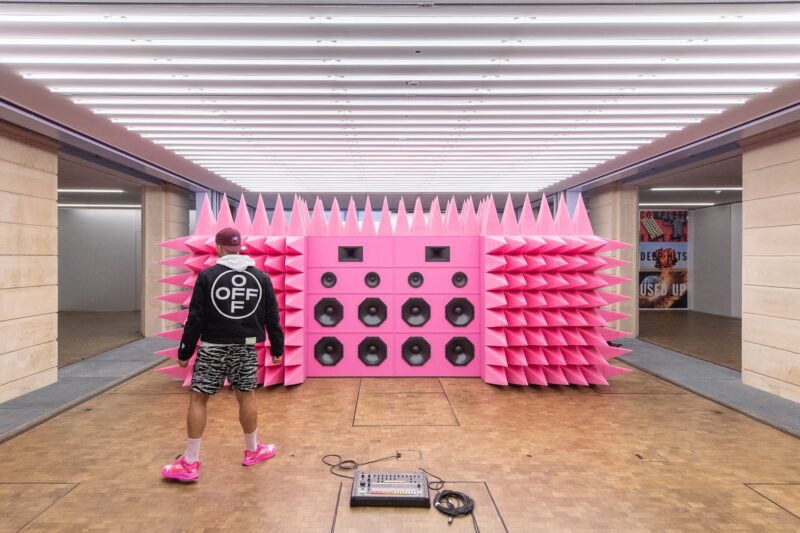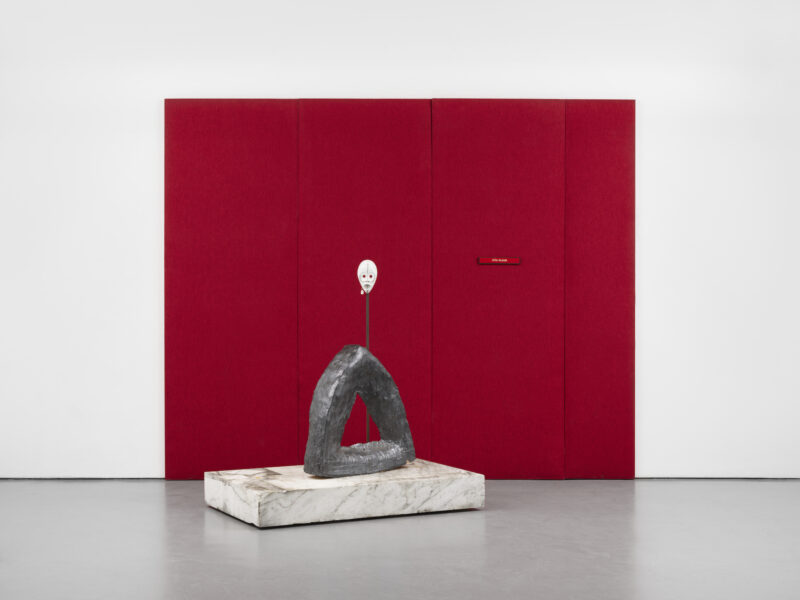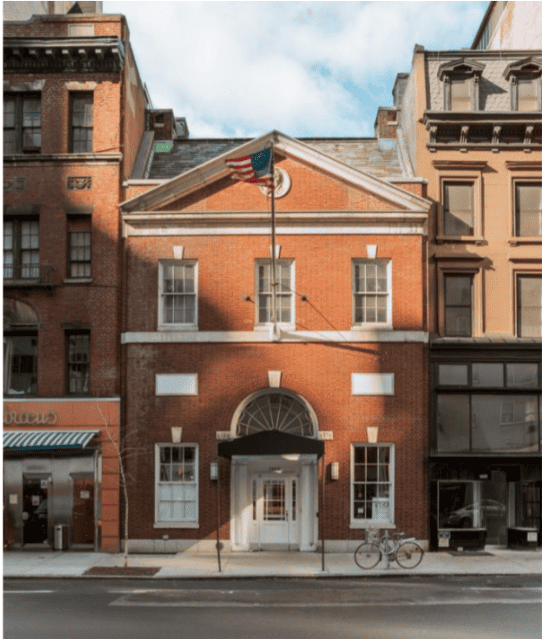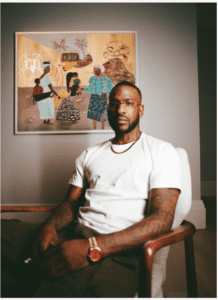Opening this week White Cube presents ‘Afro-Mingei’ by Theaster Gates (b.1973), an exhibition in which two key strands of his work – Japanese philosophy and Black identity – combine.

In the title of the show, the term ‘Afro’ refers to both African-American culture as well as to its iconic hairstyle, re-appropriated during the 1960s and 1970s by Black post-civil rights leadership as a symbol of Black identity and empowerment. The Japanese term ‘mingei’, coined by the philosopher and cultural figure Soetsu Yanagi, along with potters Shoji Hamada and Kanjiro Kawai, denotes folk or craft objects made by local, often unknown craftsmen. For Yanagi, craft challenged conventional ideas of art and beauty since it evolved from traditional practices where the divisions between art, philosophy and religion had merged or disappeared.
It is within this thematic framework that Gates presents a series of objects, installations and interventions that address different ways of looking. Incorporating various elements from Japanese culture such as sakazuki and tatami, with elements from Black culture such as African masks, soul and gospel music, he highlights hybridity as a pathway for new conceptual exploration.
Through adapting, re-forming and hand-crafting materials such as precious hard woods, stone and tar, Gates calls into question the established hierarchies of an object’s value, exposing how they are not just aesthetic forces, but signifiers of religious, political and social meaning.
‘Afro-Mingei’ opens at White Cube Mason’s Yard on 24 May and continues until 22 June 2019.
Upcoming museum exhibitions include ‘The Black Madonna’ at the Haus der Kunst, Munich (26 October 2019 – 3 May 2020) and ‘Amalgam’ at Tate Liverpool (13 December 2019 – 4 May 2020).
Theaster Gates Afro-Mingei White Cube Mason’s Yard 24 May – 22 June 2019 Preview: Thursday 23 May, 6 – 8pm whitecube.com
About The Artist
Theaster Gates’ practice includes sculpture, installation, performance and urban interventions that aim to bridge the gap between art and life. Gates works as an artist, curator, urbanist and facilitator and his projects attempt to instigate the creation of cultural communities by acting as catalysts for social engagement that leads to political and spatial change.
Gates has described his working method as ‘critique through collaboration’ – often with architects, researchers and performers – to create works that stretch the idea of what we usually understand visual-based practices to be. For his exhibition at Milwaukee Art Museum exhibition in 2010, for example, Gates invited a 250 strong gospel choir into the galleries to sing songs adapted from the inscriptions on pots by the famous 19th century slave and potter ‘Dave Drake’. For the 2010 Whitney Biennial, Gates transformed the Whitney’s Sculpture Court with a spare, architectural installation that functioned as a communal gathering space for performances, social engagement, and contemplation. For the duration of the exhibition Gates collaborated with various creative practitioners on a series of ‘monastic residencies’, holding live events such as the session by Gates’ musical ensemble, the Black Monks of Mississippi. In another recent exhibition at Seattle Art Museum, Gates transformed the gallery into an audio archive entitled ‘The Listening Room’, incorporating a hand-built DJ booth and a DJ who spinned selections from the now foreclosed Dr Wax record store in Chicago, formerly an influential hub for 60s, 70s and 80s music, in particular jazz, blues and R&B.
Gates trained as both a sculptor and an urban planner and his works are rooted in a social responsibility as well as underpinned by a deep belief system. His installations and sculptures mostly incorporate found materials – often from the neighbourhoods where he is engaged and have historical and iconic significance. In his series ‘In Event of a Race Riot’ (2011 onward) for example, lengths of decommissioned fire hoses are carefully folded, rolled or stacked and emphatically presented inside gilt box frames. Tactile and sensuous objects in themselves, the hoses have special iconic significance in relation to the civil rights struggles, in particular with regard to the hosing of peaceful demonstrators in Birmingham, Alabama in 1963. The frames act as a device for transformation but also a way to ask the viewer to think again about the still ongoing struggle for civil rights. Other sculptures derive from the stage set for performances, such as the series of shoe-shine sculptures. Made from recycled planks of wood, these over-sized, throne-like chairs emphasise the role of server and served and appear as both scaffold and monument.
Perhaps Gates most ambitious project, however, is the ongoing real estate development, simply known as ‘The Dorchester Project’. In late 2006, Gates purchased an abandoned building on 69th and Dorchester Avenue on Chicago’s South Side, collaborating with a team of architects and designers to gut and refurbish the buildings using various kinds of found materials. The building and, subsequently, several more in its vicinity, have become a hub for cultural activity housing a book and record library and becoming a venue for dinners (choreographed occasions entitled ‘Plate Convergences’), concerts and performances. Gates describes this project as ‘real-estate art’, part of a ‘circular ecological system’ since the renovations of the buildings are financed in large parts by the sale of sculptures and artworks that were created from the materials salvaged from their interiors.
In June 2018 Gates unveiled his multi-part project spanning four European institutions, entitled “Black Madonna”. The exhibitions will examine both the Black Madonna’s significance in the history of religion, as well as its aesthetic and metaphorical tenor. The project comprises a series of exhibitions and performances which draw from a range of sources, from influential depictions of the Madonna in European churches and museums, to the extensive print archive of the Johnson Publishing Corporation, the Chicago-based publisher of Jet and Ebony magazines. Black Madonna is presented at Kunstmuseum Basel, Switzerland (09 June – 21 October 2018); Sprengel Museum, Kurt Schwitters Prize Exhibition, Hannover, Germany (from 22 June 2018); Fondazione Prada, Milan, Italy (September 2018 – January 2019); and Haus der Kunst, Munich, Germany (from October 2018).
Theaster Gates was born in 1973 in Chicago where he lives and works. He has exhibited widely including solo exhibitions at the Kunstmuseum Basel, Switzerland (2018); Sprengel Museum, Hannover, Germany (2018); National Gallery of Art, Washington, DC (2017); Art Gallery of Ontario, Toronto, Canada (2016); Fondazione Prada, Milan, Italy (2016); Kunsthaus Bregenz, Austria (2016); Museum of Contemporary Art Chicago (2013); Seattle Art Museum, Washington (2011); Museum of Contemporary Art, Los Angeles (2011); Milwaukee Art Museum, Wisconsin (2010); and St. Louis Art Museum, Missouri (2010). He has participated in numerous group exhibitions including the Whitney Museum of American Art, New York (2017); 14th Istanbul Biennial (2015); 56th Venice Biennale (2015); Prospect 3, New Orleans, Louisiana (2014); Documenta 13, Kassel, Germany (2012); and Whitney Biennial, New York (2010). Gates is the recipient of the Nasher Sculpture Prize (2018), the Sprengel Museum Kurt Schwitters Prize (2017) and the Artes Mundi 6 prize (2015), and in April 2018 was appointed the first distinguished visiting artist and Director of Artist Initiatives at the Lunder Institute for American Art, Colby College, Waterville, Maine.









